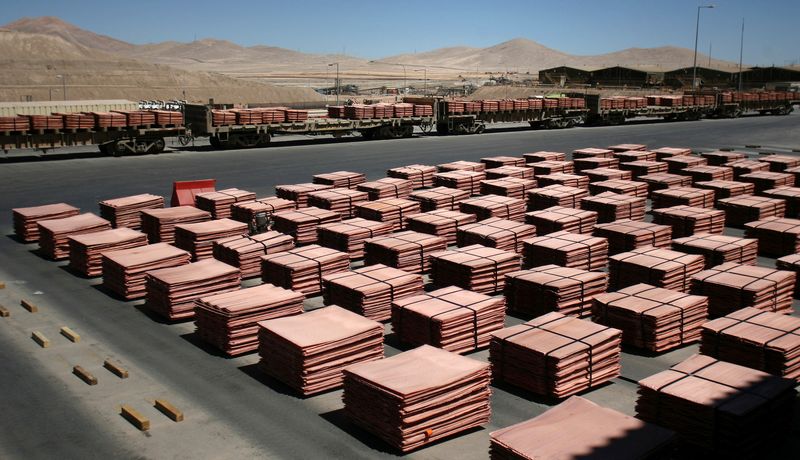By Andy Home
LONDON (Reuters) -The commodities super cycle is back with a vengeance, if performance since the start of the month is anything to go by.
The London Metal Exchange (LME) three-month copper price reached $9,640.50 per tonne on Monday, the highest trading value since June 2022.
Friday’s announcement of new US and British sanctions on Russian metal may have played a role, but if so, it played only a small part. Copper is trading just shy of that peak at $9,560 on Wednesday.
Copper below $9,500 a tonne is now cheap, according to Citi analysts, who have raised their forecasts to an average of $10,000 in the fourth quarter of this year and $12,000 in 2026.
Many other analysts do the same. Reasons to be optimistic include supply constraints, a turnaround in the old production cycle and an acceleration in the copper-intensive energy transition sectors.
The promise of further demand stimulation from artificial intelligence in the form of larger data centers is the latest trend in copper’s bull story.
The only skeptics are the physical copper users, who see no tangible signs of that promised boom in their current order books.
But does it matter? Forward-looking funds and non-direct fundamental factors are the reason that the price is currently running smoothly.
FUNDS PURCHASE
Investment funds have increased their bets on higher prices to record levels in the London market. Long positions reached 84,117 contracts at the end of last week, equivalent to more than two million tons.
That is the highest level since the LME began publishing the Commitments of Traders report in early 2018 and well above the previous peak of 67,583 in August last year.
The bulls are also in force on the CME copper contract, pushing long positions to 119,649 contracts in the week to April 9, a level last seen in January 2018.
Shorts have not capitulated on either exchange, meaning net long exposure has not surpassed the February 2021 highs. How long this will remain the case will depend on whether copper can maintain its upward momentum.
This new enthusiasm for copper appears to be part of a broader investor rotation into commodities, with gold and the rest of the industrial metals now rising to start the year after a weak first quarter.
Fund managers are apparently looking beyond the immediate headwinds of high interest rates and faltering manufacturing activity, to a boom of synchronized growth in the old and new economies.
Until a few weeks ago, the super bulls lurked in the options market, buying call options at strikes of up to $20,000 per tonne.
They are now swarming the futures market, resulting in a jump in trading activity. Average daily volumes on the CME contract rose 18% year-on-year in March, while those on the LME contract rose 21%. CME’s open interest has increased from 192,235 contracts in early March to a current 299,513.
FUTURE PERFECT
Copper’s short-term outlook remains tepid at best. Europe’s manufacturing sector remains in recession, shrinking for a 21st month in March, while the US and Chinese manufacturing sectors are showing only the first signs of expansion.
The Yangshan premium, a closely watched indicator of China’s willingness to import, has fallen to $24 from more than $100 per tonne in December, according to local data provider Shanghai Metal Market.
This year’s seasonal build for Shanghai Futures Exchange stocks is the strongest since 2020.
Key stocks in the London market appear low, but a gaping contango at the front of the curve suggests there is no immediate constraint on availability.
But as Citi notes, “investors’ belief in the future emergence of physical shortages is in itself enough to push prices higher.”
“The actual realization of strong demand, physical shortages and/or inventory declines” was not necessary to trigger the copper rally, according to an April 8 research note.
It is the future promise of copper rather than the mundane present that motivates investment managers to take their gamble. It is purely market momentum that is drawing more and more speculative money into the market, adding more fuel to the fiery rally.
SUPER RALLY
The impact of money flows on current price dynamics could be a harbinger of things to come.
Citi claims copper is now entering its second mega bull rally of the century, following that of the 2010s, when Chinese industrialization and urbanization depleted stocks and sent the price above the $10,000 level for the first time ever.
Copper’s exposure to energy transition sectors such as electric vehicles, solar and smart grids is well known, but has been overshadowed in the past year by weakness in more traditional end-use sectors such as real estate and white goods.
A recovery in the old industrial cycle promises a period of continued demand growth, with the risk of supply increasing, depleting inventories and sending prices to new record highs.
Funds will play an important role in that process, in a way they did not play during the boom at the beginning of the last century. Investment activity in the base metals sector was subdued at the time and most investors joined the bull party of the 2010s just as the last orders were declared.

This time they are leading the way and will likely become increasingly influential as a price driver as copper’s bull story unfolds.
The opinions expressed here are those of the author, a columnist for Reuters.


